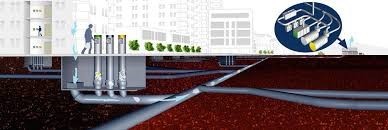Underground waste transportation system for residual waste, paper and food waste
The high-tech waste sorting and transportation system in Hammarby Sjöstad eco-city in Sweden reduces the need for waste trucks to enter the city while increasing the efficiency of waste separating. An innovative vacuum suction system transports waste fractions to the city perimeter via a series of underground tunnels.

The challenge:
Planners of Hammarby Sjöstad eco-city aimed to reduce energy consumption and waste generation while maximising resource saving, reuse of materials and recycling. Regarding municipal solid waste treatment, the main challenges for the city planners were to enable the separate collecting of waste, which better enables recovering and recycling, and to reduce the need for heavy waste-collection traffic in the residential area.
The measure:
Hammarby Sjöstad is a showcase of how to incorporate an ecocycle approach in urban planning for a whole new district. Policy makers from the City of Stockholm obtained grants from the local investment programme (LIP) for a number of projects that would demonstrate new technology in sustainable construction and housing in Hammarby Sjöstad. This grant covered only a small part of the total cost of the new town.
One of the innovative technologies incorporated in the new eco-city was a high-tech waste sorting and transportation system. The system collects three waste fractions: food waste, paper and residual waste, which households deposit into dedicated repositories located inside or just outside of buildings. These inlets are specially designed for each waste fraction – the paper depository only allows thin material such as magazines and newspapers and there is a special key for the food waste which must be enclosed in dedicated paper bags.
A vacuum suction system then propels these three waste fractions through a network of underground pipes, pumping them towards two collection terminals located outside of the residential area. From this point trucks transport the waste to recycling centres and centres for producing energy.
In total two underground waste transportation systems were built, each able to handle the waste from between 2000 and 3000 households. To complement this, regular information campaigns were undertaken to raise awareness among users about the system, and the importance of accurate waste sorting.
Lessons learnt:
The system is very popular among residents, thought to be a result of the user friendliness of the system, and the environmental benefits resulting from reduced collection traffic in the residential area. This citizens’ appreciation has coincided with very high recycling levels, with the purity of the paper and food waste fractions aiding the processing of waste to paper and biogas.
While the system installation cost was considerable – around €2000 per household – the operational costs are lower than for conventional collection methods. The management of the system is fully automated and controlled remotely, and furthermore societal costs related to the use of waste collection trucks and associated pollution are avoided.
Further deployment:
Hammarby Sjöstad was in many ways a unique project – an eco-city built from scratch, incorporating many state-of-the-art technologies. However, a number of the technologies deployed in the district, such as the waste system, have performed well over many years and the potential for replication is high. TRL 9.
